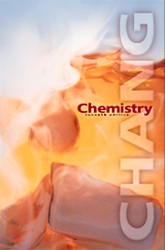 |
1 |  | 
Which of the following reactions shows the greatest increase in entropy? |
|  | A) | SO3(g) -----> 2 SO2(g) + O2(g) |
|  | B) | H2O(l) ----> H2O(s) |
|  | C) | Br2(l) ----> Br2(g) |
|  | D) | H2O2(l) ----> H2O(l) + 1/2 O2(g) |
 |
 |
2 |  | 
Without consulting entropy tables, predict the sign of DS for the following process and choose the correct reasoning for your prediction: N2(g, 10 atm) ----> N2(g, 1 atm). The mass of N2 remains constant. |
|  | A) | positive; there is an increase in the number of gas molecules. |
|  | B) | positive; the gas expands into a larger volume. |
|  | C) | negative; the gas is compressed into a smaller volume. |
|  | D) | negative; the gas expands into a larger volume. |
|  | E) | negative; there is a decrease in the number of gas molecules. |
 |
 |
3 |  | 
Which of the following reactions will have the most positive DHo? |
|  | A) | N2(g) ----> 2 N(g) |
|  | B) | F2(g) ----> 2 F(g) |
|  | C) | O2(g) ----> 2 O(g) |
|  | D) | These reactions would all have the same DHo. |
 |
 |
4 |  | 
Rubidium has a heat of vaporization of 69.0 kJ/mol and an entropy of vaporization of 71.9 J/K.mol. Calculate the boiling point of rubidium. |
|  | A) | 687 K |
|  | B) | 273 K |
|  | C) | 32 oF |
|  | D) | 687 oC |
 |
 |
5 |  | 
Calculate DSorxn for the following reaction: 4 Cr(s) + 3 O2(g) ----> 2 Cr2O3(s).| Substance | DSo, J/K·mol | | Cr(s) | 23.77 | | O2(g) | 205.138 | | Cr2O3(s) | 81.2 |
|
|  | A) | 548.1 J/K |
|  | B) | 147.7 J/K |
|  | C) | -147.7 J/K |
|  | D) | -548.1 J/K |
 |
 |
6 |  | 
For the process C6H6(l) ----> C6H6(s) at a temperature above the freezing point of C6H6, |
|  | A) | DS is positive. |
|  | B) | DH is positive. |
|  | C) | DG is positive. |
|  | D) | DG = O. |
 |
 |
7 |  | 
Keq = 7.0 at 35 oC for the reaction A + B ----> C + Calculate DGo for this reaction. |
|  | A) | 4.98 kJ |
|  | B) | 2.46 kJ |
|  | C) | 5.66 kJ |
|  | D) | 4983 kJ |
 |
 |
8 |  | 
Sodium carbonate can be prepared by heating sodium bicarbonate. 2 NaHCO3(s)
----> Na2CO3(s) + CO2(g) + H2O(g). Given that DHo = 128.9 kJ and DSo = 321 J/K·mol for this reaction, at what temperature will K = 1? |
|  | A) | 401.6 K |
|  | B) | 401.6 oC |
|  | C) | 33.1 K |
|  | D) | 33.1 |
 |
 |
9 |  | 
Consider the reaction SO2(g) + NO2(g) ----> SO 3(g) + NO(g), which occurs at 298 K. Given the information below, determine which of the following choices is correct.| compound | DGo, kJ/mol | | SO2(g) | -300.4 | | SO3(g) | -370.4 | | NO(g) | 86.7 | | NO2 | 51.8 |
|
|  | A) | K > 1; DG > 0 |
|  | B) | K > 1; DG < 0 |
|  | C) | K < 0; DG > 0 |
|  | D) | K < 0; DG < 0 |
 |
 |
10 |  | 
In the following reaction, SO2(g) + CuO(s) ----> Cu(s) + SO3(g), sulfur dioxide _____ reduce copper(II) oxide at 298 K.| substance | DHof, (kJ/mol) | So, J/K·mol | | SO2(g) | -296.2 | 248.5 | | CuO(s) | -157.3 | 42.7 | | Cu(s) | 0 | 33.5 | | SO3(g) | -395.4 | 256.1 |
|
|  | A) | will; DGo is positive. |
|  | B) | will; DGo is negative. |
|  | C) | will not; DGo is positive. |
|  | D) | will not; DGo is negative. |
|  | E) | will not; DGo = 0. |
 |



 2002 McGraw-Hill Higher Education
2002 McGraw-Hill Higher Education